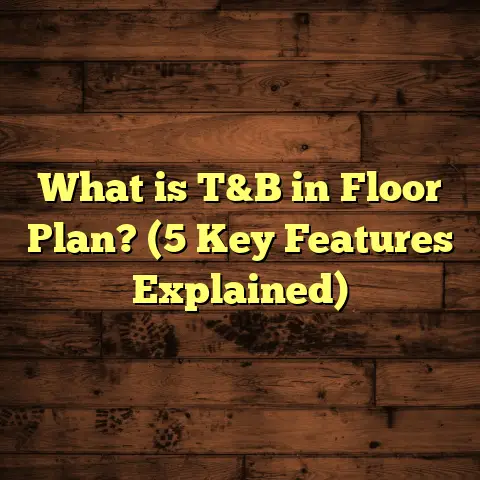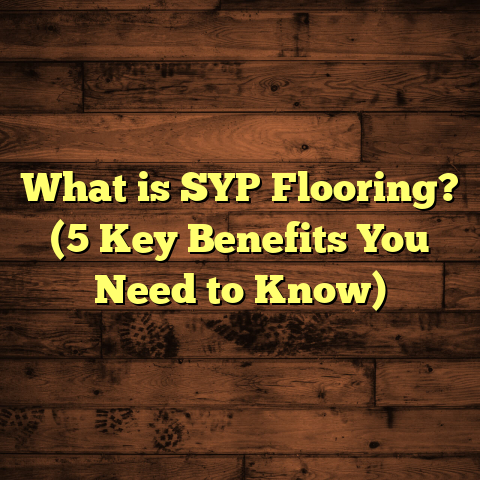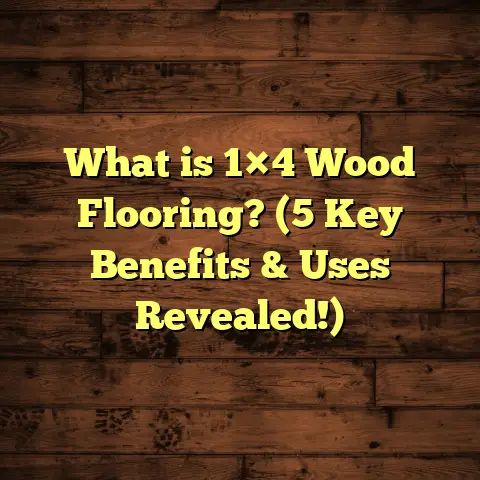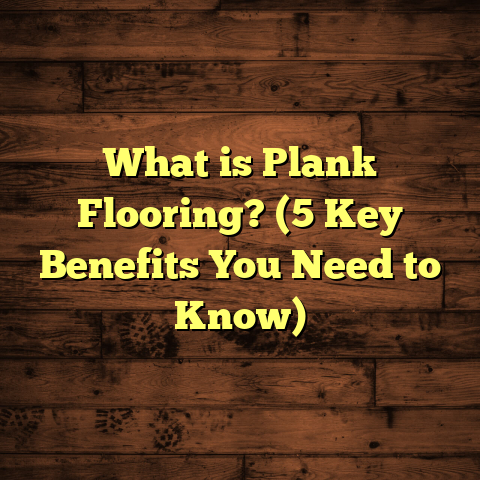What is Vinyl Click Flooring? (5 Reasons It’s a Game-Changer!)
Have you ever wondered what makes some flooring options so easy to install, durable, and stylish all at once? I used to think that getting great floors meant dealing with messy glue, expensive materials, or long installation times. Then I came across vinyl click flooring, and honestly, it changed the way I approach flooring projects entirely.
What Is Vinyl Click Flooring?
Vinyl click flooring is a type of resilient flooring that combines the benefits of vinyl’s water resistance and durability with a simple click-lock installation system. Instead of being glued down or nailed, the planks or tiles snap together using interlocking edges, creating a tight, secure fit without any adhesive.
This flooring usually consists of several layers:
- Wear Layer: The top protective film that guards against scratches, stains, and dents.
- Design Layer: A printed layer that mimics wood, stone, or other materials with high-quality visuals.
- Core Layer: Often rigid vinyl or composite material, providing stability and support.
- Backing Layer: The bottom layer that adds cushioning and moisture resistance.
What I appreciate most is how this structure offers a tough surface that feels comfortable underfoot and stands up well to everyday wear and tear.
This style of flooring is also sometimes called rigid core vinyl click flooring or LVT (luxury vinyl tile) click flooring. The “click” part refers to the tongue-and-groove edges that snap together like puzzle pieces. This means no glue or nails are necessary to keep the floor in place—a huge advantage for many homeowners and contractors.
How Did Vinyl Click Flooring Come About?
I like to understand the background of materials I work with. Vinyl flooring has been around since the 1930s but was mostly sheet vinyl for decades. The click system evolved later as manufacturers looked to simplify installation while improving durability.
The first vinyl planks were introduced in the early 2000s. These planks offered realistic looks and easier installation but often still needed glue. Then came the click-lock mechanism, adapted from laminate flooring technology, which revolutionized how vinyl floors are installed.
By 2015, click vinyl floors gained huge popularity in both residential and commercial spaces due to:
- Faster installation.
- Less mess.
- Ability to float over existing floors.
- Increased durability.
The National Floor Covering Association reports that sales of vinyl click flooring have increased by nearly 40% over the past five years in the US alone. This trend reflects consumer demand for easy-to-install yet durable floors.
What Makes Vinyl Click Flooring Different?
When I first saw vinyl click floors at a trade show, I was curious how they stacked up against other common options:
- Hardwood
- Laminate
- Tile
- Sheet vinyl
- Carpet
Each has pros and cons but here are a few ways vinyl click stands apart:
Water Resistance
Unlike hardwood or laminate, vinyl is inherently waterproof or water-resistant. That means it won’t swell or warp when exposed to moisture. This makes it perfect for kitchens, bathrooms, basements, or even laundry rooms where spills and humidity are common.
Installation Ease
Because it snaps together without adhesive or nails, vinyl click floors are faster and cleaner to install. This floating system also means you can install over existing floors without demolition in many cases.
Durability
Vinyl click floors are designed with a tough wear layer that resists scratches and stains better than laminate or hardwood in many situations.
Comfort
Vinyl tends to feel softer and warmer underfoot compared to tile or hardwood—great if you spend a lot of time standing.
Cost-Effectiveness
Compared to hardwood or tile, vinyl click floors offer a good balance of quality and price. Plus, the savings on installation labor make it even more affordable.
My First Experience Installing Vinyl Click Flooring
I remember my first real project with vinyl click flooring vividly. It was for a client who wanted an affordable alternative to hardwood in her newly finished basement. The subfloor was concrete and slightly uneven, but because vinyl click flooring floats over imperfections, we didn’t need heavy leveling.
We acclimated the planks for 48 hours beforehand and then began locking them together row by row. The installation took about half the time compared to traditional glue-down vinyl tiles I’d worked with before.
When we finished, the client was thrilled with how natural the wood-look planks seemed and how comfortable they were underfoot. She loved that she didn’t have to wait days before using the room again—the floor was ready to go immediately.
That project sparked my interest in vinyl click flooring—how such a simple design could solve so many common flooring headaches.
How Vinyl Click Flooring Works: A Technical Breakdown
Let’s get into some technical details for those who want a deeper understanding:
Layers Explained
- Wear Layer This is the clear topcoat that protects your floor from scratches, stains, and scuffs. Thickness varies between 6 mil (0.15 mm) for residential use up to 20 mil (0.5 mm) for commercial-grade products. More wear layer thickness means better durability but usually higher cost.
- Design Layer A high-resolution printed film that produces the realistic look of wood grain, stone veining, or other textures. Advances in printing technology allow manufacturers to replicate natural materials nearly perfectly now.
- Core Layer The heart of the plank—this rigid layer provides stability and impact resistance. It’s often made from:
- Rigid Vinyl Composite (RVC)
- Stone Plastic Composite (SPC)
- Wood Plastic Composite (WPC)
- Backing Layer Provides cushioning and moisture barrier protection. Some backings include underlayment attached for sound reduction and comfort.
Click Lock System
I’ve found this makes repairs easier too—if a plank gets damaged, you can replace just that piece instead of ripping up the entire floor.
Installation: Step-by-Step Guide from My Experience
Installing vinyl click flooring is one of the most satisfying projects because it offers quick results without sacrificing quality. Here’s how I approach it:
Step 1: Acclimate Your Flooring
Let your vinyl planks sit in the room where they’ll be installed for at least 48 hours. This prevents issues later due to expansion or contraction from temperature changes.
Step 2: Prepare the Subfloor
Make sure your subfloor is clean, dry, flat, and free from debris or bumps. Small imperfections can cause clicking problems or uneven surfaces.
For concrete subfloors, check moisture levels with a moisture meter—vinyl is water-resistant but excessive moisture can still cause problems underneath.
Step 3: Gather Tools
You don’t need much:
- Tape measure
- Utility knife
- Straight edge
- Spacers
- Rubber mallet (for gentle tapping)
- Pencil
Step 4: Plan Your Layout
Decide on your starting wall—usually the longest straight wall—and lay out your first row accordingly. Use spacers along walls to leave about 1/4 inch gap for expansion.
Step 5: Snap Planks Together
Begin snapping planks together by angling one plank into another at about 20 degrees and pressing down until it clicks flat.
Use a rubber mallet gently if needed to lock edges firmly.
Step 6: Cut End Pieces
Measure and cut planks at end rows with a utility knife using a straight edge for clean cuts. Scoring multiple times then snapping often works well.
Step 7: Finish Edges
Use trim molding or baseboards to cover expansion gaps along walls for a polished look.
I once helped a friend who installed his own vinyl click floor in his rental apartment. He followed this method exactly but forgot spacers along one wall—after a few weeks he noticed slight buckling near windows where temperature swung dramatically. After correcting by removing some trim and adding spacers, the issue resolved quickly.
Maintenance Tips That Keep Floors Looking New
One reason I like vinyl click flooring so much is how little fuss there is after installation:
- Sweep or vacuum regularly to remove grit that can scratch.
- Mop occasionally with warm water and mild detergent.
- Avoid abrasive scrubbers or harsh chemicals.
- Wipe spills immediately.
- Use felt pads on furniture legs.
- Place mats at entrances to reduce dirt tracked in.
Avoid waxing or polishing as it can damage the wear layer.
In one case study I read involving an active family with pets, their vinyl click floor stayed beautiful for over eight years with just basic maintenance—no refinishing required!
Comparing Vinyl Click Flooring With Other Flooring Types
Here’s how I see vinyl click floors stack up against other popular choices:
| Feature | Vinyl Click Flooring | Hardwood Flooring | Laminate Flooring | Tile Flooring |
|---|---|---|---|---|
| Water Resistance | High | Low | Moderate | Very High |
| Installation Ease | Very Easy (DIY friendly) | Moderate (pro recommended) | Easy (DIY possible) | Difficult (pro recommended) |
| Durability | High | Moderate | Moderate | Very High |
| Cost | $3–$7/sq ft | $8–$15/sq ft | $4–$8/sq ft | $5–$12/sq ft |
| Comfort | Soft underfoot | Hard | Hard | Hard |
| Appearance Variety | Very good | Excellent natural look | Good | Excellent variety |
| Repairability | Easy plank replacement | Difficult | Moderate | Difficult |
From my experience helping clients pick floors based on their budget and lifestyle needs, vinyl click is often the best middle ground if you want something attractive but low maintenance.
Case Study #1: Family Basement Renovation
A couple I worked with had an unfinished basement prone to humidity issues. They wanted something warm underfoot but resistant to moisture damage because of occasional flooding risk.
We chose an SPC core vinyl click floor with 12 mil wear layer in a light oak finish. After installation:
- The floor handled minor floods without damage.
- No mold or mildew issues developed after two years.
- The clients reported satisfaction with comfort compared to tile alternatives they considered.
- Installation was done DIY over a weekend saving them about $1,200 in labor costs.
Case Study #2: Commercial Daycare Center
For a local daycare center renovating play areas, durability was key due to heavy foot traffic and frequent cleaning needs.
They opted for commercial-grade vinyl click flooring with:
- 20 mil wear layer.
- Antimicrobial surface coating.
- Attached underlayment for noise reduction.
After three years:
- Minimal wear despite heavy use.
- Management appreciated ease of cleaning spills and sanitizing.
- The floating installation allowed future repairs without major disruption.
This is a prime example of how vinyl click floors can hold up in demanding environments beyond homes.
Cost Analysis – Breaking Down Your Budget
Let’s talk numbers based on recent pricing data from retailers and installers:
Material Costs
- Entry-level residential vinyl click flooring: $2 – $3 per sq ft
- Mid-range options with thicker wear layers/designs: $3 – $5 per sq ft
- High-end commercial-grade: $5 – $7 per sq ft
Installation Costs
If hiring professionals:
- Labor ranges from $1 – $3 per sq ft depending on region and complexity.
- DIY installation can save this entirely but requires some skill/time investment.
Additional Costs
Don’t forget trims, underlayment (if not attached), tools rental/purchase, and subfloor prep might add $0.50 – $1 per sq ft depending on needs.
For a 500 sq ft room:
| Expense | Low-End ($) | Mid-Range ($) | High-End ($) |
|---|---|---|---|
| Materials | 1,000 | 1,750 | 3,500 |
| Installation Labor | 500 | 1,000 | 1,500 |
| Extras | 250 | 500 | 750 |
| Total | 1,750 | 3,250 | 5,750 |
Compared to hardwood floors which can easily top $10K installed for similar space size, vinyl click provides an affordable option with solid performance.
Frequently Asked Questions From My Clients
Q: Can I install vinyl click flooring myself?
A: Yes! It’s one of the easiest flooring systems for DIYers because it requires no glue or nails—just snapping planks together like puzzle pieces.
Q: Will vinyl click floors fade in sunlight?
A: Most modern products have UV inhibitors protecting against fading when exposed to sunlight for long periods.
Q: Can I install over carpet?
A: It’s not recommended as carpet doesn’t provide firm support needed for floating floors. Remove carpet first or install over hard subfloor.
Q: How long does vinyl click flooring last?
A: With proper care, residential products typically last 10–20 years; commercial-grade options can last longer under heavy use.
Q: Is vinyl click flooring eco-friendly?
A: Many manufacturers now produce low-VOC products meeting environmental certifications like FloorScore®; some use recycled content too.
Personal Tips For Choosing the Right Vinyl Click Flooring
When picking your floors:
- Decide on wear layer thickness based on expected foot traffic.
- Consider core type: SPC for rigidity vs WPC for comfort.
- Choose visuals that complement your space style; visit showrooms if possible.
- Don’t forget sound insulation if installing upstairs; attached underlayment helps.
- Ask about warranties—most top brands offer 10+ years on wear layers.
My Final Thoughts on Vinyl Click Flooring
Over years working as a contractor and homeowner myself, vinyl click flooring has proven itself reliable across many scenarios—from busy kitchens to relaxed living rooms and even commercial settings. It offers an unbeatable combination of style versatility, durability, water resistance, and ease of installation that suits many budgets and lifestyles.
If you ever feel overwhelmed by flooring choices again, consider giving vinyl click flooring a closer look—you might find it ticks all your boxes like it did mine!
If you want help figuring out what product best fits your project or tips on tackling installation step by step, just ask! I love sharing what I’ve learned from dozens of projects like these. What questions do you have about vinyl click flooring?





